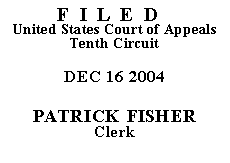

| UNITED STATES of AMERICA, | No. 04-2111
(D.C. No. CR-03-534-MCA) (Dist. N.M.) |
Section 2K2.1(b)(5), in pertinent part, directs the district court to increase a defendant's base offense level by four "[i]f the defendant used or possessed any firearm or ammunition in connection with another felony offense." "[W]e have held generally that if the weapon facilitated or had the potential to facilitate the underlying felony, then enhancement under § 2K2.1(b)(5) is appropriate." United States v. Gatewood, 370 F.3d 1055, 1064 (10th Cir. 2004) (quotation omitted), petition for cert. filed, (U.S. Sept. 2, 2004) (No. 04-6266). "However, the enhancement is not appropriate if possession of the weapon is coincidental or entirely unrelated to the offense." Id. (quotation omitted).
At sentencing, the district court adopted the presentence report's factual findings (R. supp. v. I at 6.), which indicated the following: On November 10, 2001, there was a drive-by shooting at a residence in Roswell, New Mexico, during which a pregnant woman was shot. (R. v. II at 2.) Later that night, police located Horton, with two other men, a few blocks away, standing next to a white vehicle matching the description of the vehicle used in the drive-by shooting. (Id. at 2-3.) When police drove up, these three men ran into a nearby apartment. (Id. at 3.) A nine-millimeter Ruger pistol and several clips of nine-millimeter ammunition were found in that apartment. (Id.) Ballistics tests established that the Ruger was the gun used in the drive-by shooting. (Id.) And Horton's fingerprints were found on one of the ammunition clips. (Id.)
At sentencing, Horton did not object to these facts. (R. v. I, doc. 32 at 1-2; supp. v. I at 3-4.) Rather, Horton argued only that these facts did not justify the four-level increase under § 2K2.1(b)(5). (R. v. I, doc. 32 at 1-2; supp. v. I at 3-4.)
Horton pled guilty to possessing the Ruger and the ammunition. (R. v. III at 3, 8). We note that, at the plea proceeding, the Government asserted it had evidence to prove these same facts, and Horton did not dispute that, either. (R. v. III at 5-8.) Nor did Horton dispute the Government's assertion that it had further evidence indicating that at least some of the occupants in the car used for the drive-by shooting were wearing red shirts and hats. (Id. at 6.) When police found Horton and his two acquaintances later that evening, two of them were wearing red shirts and hats. (Id.) Further, when police were outside the apartment where these three men had run, officers overheard two of the men discussing hiding the gun. (Id.) In light of these undisputed facts, the district court did not err in applying § 2K2.1(b)(5) and increasing Horton's offense level by four.
After the district court sentenced Horton, the Supreme Court decided Blakely v. Washington, 124 S. Ct. 2531 (2004). "In Blakely, a direct criminal appeal, the Supreme Court held that the State of Washington's sentencing procedures violated the defendant's constitutional right under the Sixth Amendment because facts essential to his sentence were not proven to a jury beyond a reasonable doubt or admitted by him." Leonard v. United States, 383 F.3d 1146, 1147 (10th Cir. 2004). Horton now asserts that Blakely requires that his sentence be vacated because a jury did not make the factual findings underlying the four-level increase under U.S.S.G. § 2K2.1(b)(5). In Blakely, however, "[t]he Court . . . did not invalidate the Federal Sentencing Guidelines or hold that Blakely applies to the Federal Sentencing Guidelines." Leonard, 383 F.3d at 1147. Nor do we need to address that issue here. Even if Blakely does apply to the federal guidelines, Horton would not be entitled to relief.
Before the district court, Horton did not object to the district court's making the factual findings at issue under § 2K2.1(b)(5). Our review, therefore, would be for plain error. See United States v. Maldonado-Ramires, 384 F.3d 1228, 1230 n.1 (10th Cir. 2004) (in dicta). Under a plain-error analysis, "[t]his court will correct an error not raised before the district court only if: (1) there is an error; (2) that is plain; (3) that affects substantial rights; and (4) that seriously affects the fairness, integrity, or public reputation of the judicial proceedings." Id. (quotation omitted). Here, the district court's making the factual finding that Horton's Ruger was used in another felony did not "affect the fairness, integrity, or public reputation of the judicial proceedings." Id. (quotation omitted). Horton admitted to possessing the firearm. And he never disputed that the firearm had been used during the drive-by shooting or that his fingerprints were on the ammunition clip. In fact, all "the facts necessary for the district court to decide the applicability of [§ 2K2.1(b)(5)] were uncontested." Maldonado-Ramires, 384 F.3d at 1230 n.1 (in dicta).
For these reasons, therefore, we AFFIRM Horton's sentence.
ENTERED FOR THE COURT
David M. Ebel
Circuit Judge
*.After examining the briefs and appellate record, this panel has determined unanimously to grant the parties' request for a decision on the briefs without oral argument. See Fed. R. App. P. 34(f) and 10th Cir. R. 34.1(G). The case is therefore ordered submitted without oral argument. This Order and Judgment is not binding precedent, except under the doctrines of law of the case, res judicata, and collateral estoppel. The court generally disfavors the citation of orders and judgments; nevertheless, an order and judgment may be cited under the terms and conditions of 10th Cir. R. 36.3.